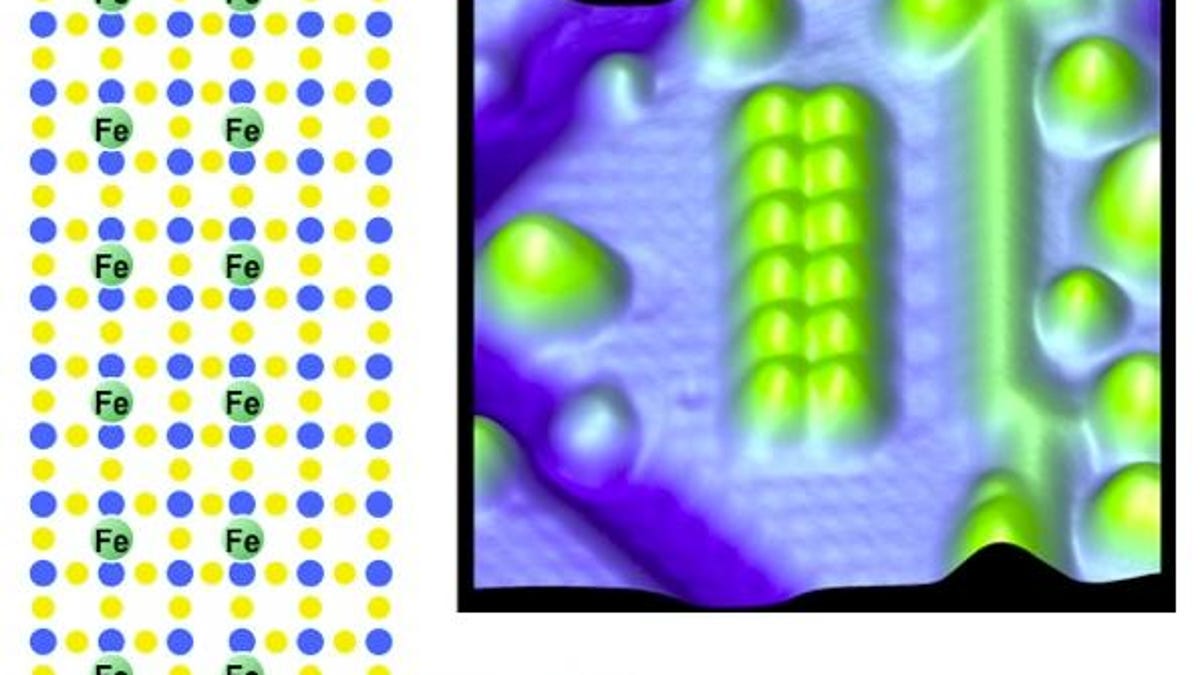IBM creates data storage at the atomic level
A new discovery by Big Blue researchers suggests that it's possible to store a bit of information in as little as 12 magnetic atoms. Today's disk drives require a million atoms to store a bit.

SAN JOSE, Calif.--With a discovery that could some day fundamentally alter the scale of mass data storage, nanotechnology researchers at IBM say they have found a way to store a bit of information in as little as 12 magnetic atoms.
That's a radical improvement over today's storage devices which, IBM argues, require about a million atoms to hold a bit of information. For those keeping score at home, IBM's discovery could mean storage could one day be possible at 1/83,000th the scale of today's disk drives.
And while the IBM researchers behind the breakthrough say there is no time frame for bringing their work to market, it's clear that the company sees this as a way to one day develop storage that breaks the mold of what's possible today and drastically reduces the size of drives, while significantly boosting their speed and energy efficiency.
In coming up with the atomic-scale memory system, IBM realized an entirely new approach was required if it wanted to break through the physical limits of today's technology, it said. IBM published its findings in "Science" magazine this morning.
The technology industry has depended for years on Moore's Law--in which the number of transistors that can be placed on an integrated circuit doubles every two years--to make smaller and smaller devices. But according to Andreas Heinrich, the lead atomic storage researcher at IBM, ultimately, that means shrinking down to the scale of atoms. And it's not possible to shrink beyond that, he said.
At IBM's Almaden Research Center here, Heinrich and his team set out to see if they could start at the atomic level and build up from there, rather than waiting for Moore's Law to get there in ten or 20 years. "We are explorers in the field of starting from atoms and building structures that might be useful for IBM or other players in industry," Heinrich told CNET.
The question that Heinrich's team has been trying to answer is how many atoms it would take to create a magnetic bit in which it was possible to store information. And they've now arrived at the answer: 12.
And that means that in the future, scientists may be able to apply what they say is an unconventional type of magnetism known as "antiferromagnetism" that could make it possible for data storage at 100 times the level of anything that can be done today.
The process
Computers' understanding of information starts with the bit. A bit can have just two values--one or zero. IBM says that prior to this development, it was unclear how many atoms would be required to create a reliable memory bit.
"With properties similar to those of magnets on a refrigerator, ferromagnets use a magnetic interaction between its constituent atoms that align all their spins--the origin of the atoms' magnetism--in a single direction," IBM said in a release about the storage discovery. "Ferromagnets have worked well for magnetic data storage but a major obstacle for miniaturizing this down to atomic dimensions is the interaction of neighboring bits with each other. The magnetization of one magnetic bit can strongly affect that of its neighbor as a result of its magnetic field. Harnessing magnetic bits at the atomic scale to hold information or perform useful computing operations requires precise control of the interactions between the bits."
In order to achieve this control, Heinrich and his team used IBM Almaden's scanning tunneling microscope to "atomically engineer 12 antiferromagnetically coupled atoms" that were capable of holding on to a data bit for several hours at temperatures as low as 4 degrees Kelvin. And that meant that by leveraging the "inherent alternating magnetic spin directions," Heinrich and his fellow researchers showed that it is possible to place adjacent magnetic bits far closer together than has ever been done before.
While Heinrich has now shown that storage is possible at many magnitudes smaller scale than ever, it will likely be many years before this results in any kind of marketable technology, he said. It will take quite some time before he and his team can move this new technology out of the lab, and creating products from the discovery is a business decision, not one that will be made by Heinrich and his fellow researchers. "We have the luxury of now worrying about [manufacturing]," Heinrich said. "Our mission is to figure out what we want to build, but now worry about how it's practical" because that's a huge next step.

